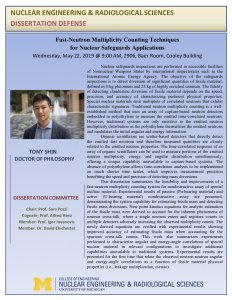Presented By: Nuclear Engineering & Radiological Sciences
PhD Defense: Tony Shin
Fast-Neutron Multiplicity Counting Techniques for Nuclear Safeguards Applications

Title: Fast-Neutron Multiplicity Counting Techniques for Nuclear Safeguards Applications
Chair: Prof. Sara Pozzi
Abstract: Nuclear safeguards inspections are performed in accessible facilities of Nonnuclear Weapons States by international inspectorates such as the International Atomic Energy Agency. The objective of the safeguards inspections is to detect diversion of significant quantities of fissile material, defined as 8 kg plutonium and 25 kg of highly enriched uranium. The fidelity of detecting clandestine diversion of fissile material depends on the speed, precision, and accuracy of characterizing pertinent physical properties. Special nuclear materials emit multiplets of correlated neutrons that exhibit characteristic signatures. Traditional neutron multiplicity counting is a well- established method that uses an array of capture-based neutron detectors embedded in polyethylene to measure the emitted time-correlated neutrons. However, traditional systems are only sensitive to the emitted neutron multiplicity distribution as the polyethylene thermalizes the emitted neutrons and modulates the initial angular and energy information.
Organic scintillators are scatter-based detectors that directly detect the emitted fast neutrons and therefore measured quantities are closely related to the emitted neutron properties. The time-correlated response of an array of organic scintillators can be used to measure portions of the emitted neutron multiplicity, energy, and angular distribution simultaneously, offering a unique capability unavailable to capture-based systems. The absence of polyethylene allows time-correlation analysis to be implemented on much shorter time scales, which improves measurement precision benefiting the speed and precision of detecting mass diversions.
This dissertation summarizes the feasibility and improvements of a fast-neutron multiplicity counting system for nondestructive assay of special nuclear material. Experimental results of passive (Pu-bearing material) and active (U-bearing material) nondestructive assay are presented, demonstrating the system capability for estimating fissile mass and detecting fissile mass diversions. New point kinetics equations for analytic estimation of the fissile mass were derived to account for the inherent phenomena of neutron cross-talk, where a single neutron enters and registers counts in multiple detectors adversely increasing the observed multiplicity counts. The newly derived equations are verified with experimental results showing improved accuracy of estimating fissile mass when accounting for the spurious cross-talk counts. This work also summarizes experiments performed to characterize angular and energy-angle correlations of special nuclear material in relevant configurations to investigate additional capabilities unavailable to traditional systems. Experimental results are presented for the first time that relate the observed neutron-neutron angular and energy-angle correlations as a function of fissile material physical properties (i.e., leakage multiplication, α-ratio).
Chair: Prof. Sara Pozzi
Abstract: Nuclear safeguards inspections are performed in accessible facilities of Nonnuclear Weapons States by international inspectorates such as the International Atomic Energy Agency. The objective of the safeguards inspections is to detect diversion of significant quantities of fissile material, defined as 8 kg plutonium and 25 kg of highly enriched uranium. The fidelity of detecting clandestine diversion of fissile material depends on the speed, precision, and accuracy of characterizing pertinent physical properties. Special nuclear materials emit multiplets of correlated neutrons that exhibit characteristic signatures. Traditional neutron multiplicity counting is a well- established method that uses an array of capture-based neutron detectors embedded in polyethylene to measure the emitted time-correlated neutrons. However, traditional systems are only sensitive to the emitted neutron multiplicity distribution as the polyethylene thermalizes the emitted neutrons and modulates the initial angular and energy information.
Organic scintillators are scatter-based detectors that directly detect the emitted fast neutrons and therefore measured quantities are closely related to the emitted neutron properties. The time-correlated response of an array of organic scintillators can be used to measure portions of the emitted neutron multiplicity, energy, and angular distribution simultaneously, offering a unique capability unavailable to capture-based systems. The absence of polyethylene allows time-correlation analysis to be implemented on much shorter time scales, which improves measurement precision benefiting the speed and precision of detecting mass diversions.
This dissertation summarizes the feasibility and improvements of a fast-neutron multiplicity counting system for nondestructive assay of special nuclear material. Experimental results of passive (Pu-bearing material) and active (U-bearing material) nondestructive assay are presented, demonstrating the system capability for estimating fissile mass and detecting fissile mass diversions. New point kinetics equations for analytic estimation of the fissile mass were derived to account for the inherent phenomena of neutron cross-talk, where a single neutron enters and registers counts in multiple detectors adversely increasing the observed multiplicity counts. The newly derived equations are verified with experimental results showing improved accuracy of estimating fissile mass when accounting for the spurious cross-talk counts. This work also summarizes experiments performed to characterize angular and energy-angle correlations of special nuclear material in relevant configurations to investigate additional capabilities unavailable to traditional systems. Experimental results are presented for the first time that relate the observed neutron-neutron angular and energy-angle correlations as a function of fissile material physical properties (i.e., leakage multiplication, α-ratio).